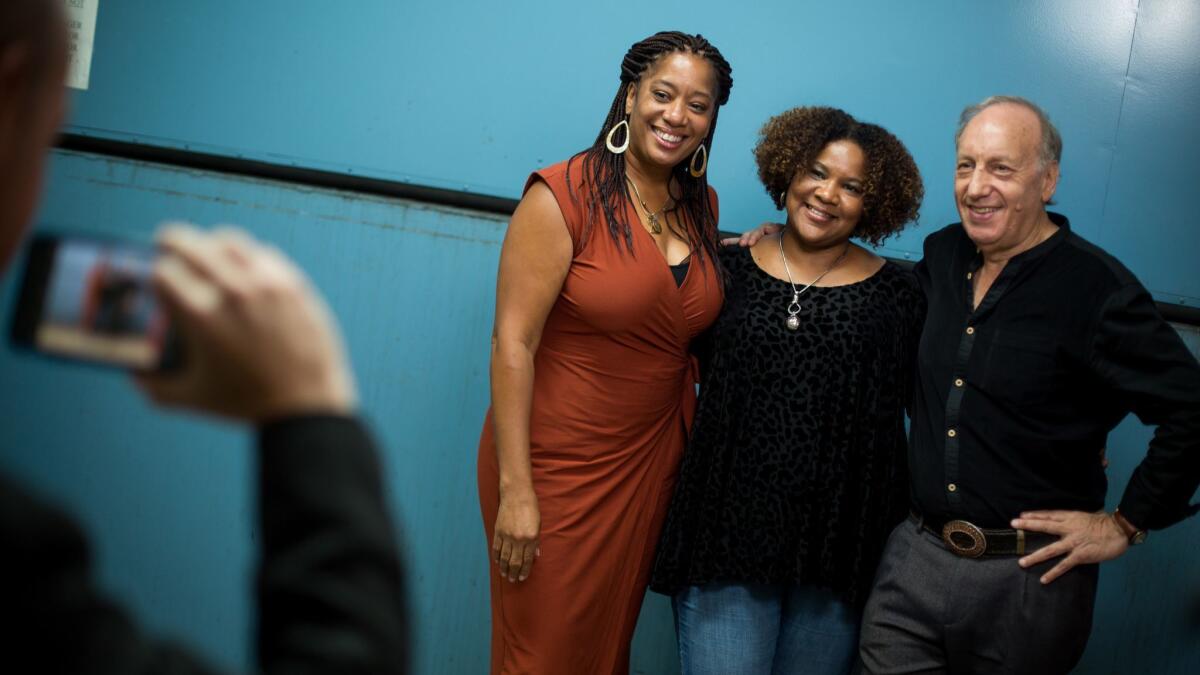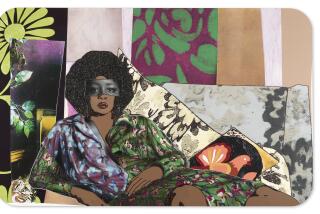On âAmerican Masters,â relatives open up about the famous artists in their families

The families of famous painters often stay in the shadows. You donât know as much about Lola and ConcepciĂłn Picasso as you do their big brother, Pablo. Many choose to stay out of the spotlight that their siblingsâ or parentsâ success inevitably draws toward them.
But family is a running theme in the newest award-winning âAmerican Mastersâ series on PBS called âArtists Flight,â a quartet of projects that include films about sculptor-painter Eva Hesse, painter Elizabeth Murray, painter-illustrator Andrew Wyeth and painter-illustrator Jean-Michel Basquiat.
Each person in the âArtists Flightâ series was more than the descriptor placed before their names. Hesse was not only a sculptor but also an artist who escaped Nazi Germany as a child and whose life was cut short by a brain tumor at 34. Murray died of cancer in 2007, but the renowned painter was also only the fifth woman ever to be celebrated with a retrospective at the Museum of Modern Art. Wyeth had his first exhibition at age 20, and his immense popularity drew scorn and criticism from the art world of the late â40s and â50s. Conversely, Basquiat was almost universally loved by the art world, and though his art still fetches millions of dollars from Sothebyâs crowds, his activism and often racially tinted artistry was cut down early by a heroin overdose.
The artistsâ stories are tinged with sadness, but tragedy is far from the theme of the films, with all celebrating the lives lived through the eyes of not only art historians and museum curators but friends and family as well â some of whom had rarely ever spoken about their genius siblings on film.
The first, âAmerican Masters: Eva Hesse,â premiered on PBS Aug. 31 and is available for free streaming on pbs.com/americanmasters (all of the films will be available after they air).
Selma Blair is the voice of Eva Hesse, and Evaâs sister, Helen, features prominently in the film. Helen and her sister escaped Nazi Germany in December 1938 aboard one of the last Kindertransport trains, reuniting with their parents months later. But it was not that early experience that shaped young Eva, according to Helen.
âHer life was her art. Art was the essence of her being. That comes out so well in the film â it was everything to her,â said Helen. âIt gave her security and it gave her her persona.â
While focusing on Hesseâs persistence and drive, director Marcie Begleiter also attempted to capture the life of an artist who went from paintings and drawings to sculptures and continued to evolve.
âWhat I kept coming back to was that we wanted to make an image of a multifaceted object,â said Begleiter. âSomething that changed. Every time you looked at it from a different direction, it would reflect a different piece,â
âMy inspiration from her was her connection to creativity in the face of mortality.â And despite her sisterâs fatal brain tumor, Helen says that her sister âwas not a tragic figure.â
The theme of family continues with Elizabeth Murray in âAmerican Masters: Everybody Knows ⌠Elizabeth Murray,â which premieres Sept. 7 at 9 p.m. She was well-known in the art world but not so much outside of it. The artist took care of her children and was a full-time painter.
Director Kristi Zea identified with her friend and believed others would too when she decided to make the film.
â[She was] suffering through the same dilemmas that a lot of women do who want to have great lives both as a family person, as a mother, and also as an artist,â said Zea. âIt was such a mission to me to want to explain to people that it is possible. Itâs hard, but itâs possible. And also to tell the story of this amazing woman.â
Unlike other subjects, the film was envisioned while Murray was still a vibrant artist creating colorful works that were bright and full of life. Then the production took a turn.
âTragically, very early on in the process, we found out that Elizabeth was very ill. That changed everything,â said Zea. âWhen we first started doing it, no one had an inkling of how sick she was. I started filming her immediately ... We never thought it would take a turn as dire as it did.â
Murray continued to paint until she died of cancer in 2007. Zea unearthed journals that Murray had kept and, through them, found another voice.
âI thought, âThereâs another character in the film.â I immediately thought of Meryl Streep. I had just finished working with her on a film with Jonathan Demme called âManchurian Candidate,â â said Zea.
Turns out, Streep knew Murrayâs story well and had met the artist. She made such an impression that, when asked, Streep said yes to narrating the film as the voice of Murray reading her journals.
âIn two hours, we had done them all, and she absolutely channeled Elizabeth,â said Zea.
It was access that allowed Zea to find the journals. In âAmerican Masters: Wyeth,â which also premieres on Sept. 7, but at 10 p.m., Andrew Wyethâs family allowed filmmakers unprecedented access to family members, including sons Jamie and Nicholas.
Jamie recounts how he learned about art and the influences that his famous, and infamous, father and grandfather had on him while growing up.
âN.C. Wyeth [was] an illustrator who was sort of the flagship of illustration back in the mid-century. I never knew my grandfather, but as a child, he excited me much more than my fatherâs work. My God, he was painting pirates and knights and battles and so forth, so Iâd go up to his empty studio â which was physically higher up on the hill than our house, and it was full of costumes and cutlasses and rifles. Very exciting things. And then all the illustrations were still there and stacked up. And then Iâd wander back to our own house, which was our fatherâs studio, and heâd be painting some dead bird. That just bored the hell out of me. There was that contrast.â
The film shows how Andrew Wyeth was shunned by critics for being too popular with the mainstream masses. His lifelike images and the detail of his drawings and paintings were hits on the commercial art scene more than with the highbrow crowd. Though the bar for art has been raised, there are still some anti-Wyeth naysayers.
âHe still raises hackles on people and thatâs what [the film] deals with,â says Jamie. âThe hate from certain groups who feel his work is too accessible. If the public likes it they think itâs gotta be bad, or itâs got to be pandering, and itâs not. Itâs very strange work.â

David Schulman, director of âAmerican Masters â Basquiat: Rage to Richesâ and Jean-Michel Basquiatâs sister Lisane talk about the artist and his drive to succeed.
From popular to uber popular, the last film in the âArtists Flightâ series, âAmerican Masters â Basquiat: Rage to Riches,â premiering Sept. 14, zeroes in on one of the most popular contemporary artists of the last few decades. A Jean-Michel Basquiat painting sold last year for $110.5 million â the most ever for an American painting. The artist was known as a champion of civil rights and gave voice to those concerns through his art.
But his sister Lisane wants his art to shine whenever he is remembered by fans or historians.âTheyâre best served seeing my brother as an inspiration instead of a martyr,â said Lisane.
She and her sister Jeanine contributed to the film despite being very private about family matters. Lisane also saw her brother as not just an artsy type, but a responsible person â something she wanted the film to also convey.
âJust the pure grit that he had and that he exuded in making sure that he met his dreams, accomplished what he set out to accomplish and he took ownership and responsibility for his own success and the path of his own life.â

This sentiment is shared by âBasquiatâ director and producer David Shulman, himself an artist in the â80s New York art scene that Basquiat inhabited.
âHe was incredibly smart, incredibly determined, incredibly resourceful and creative in achieving what he wanted to achieve. It was very much driven by him. He was, to a large extent, in control of his own destiny, and he decided to play this game of the art world on his own terms given the content and the scene that he was actually into,â said Shulman.
The âArtists Flightâ series aims to show âhow diverse the art world is and that now, thanks to these pioneers, thereâs room for everyone,â according to âAmerican Mastersâ executive producer Michael Kantor. As smaller, art house films, each of these projects did not command the audience that they can through multiple airings on PBS and continued streams on its site.
But will people tune in? Begleiter voices what is specific to âEva Hesse,â but can most likely be applied to each of the films.
âYou hear the words âarts documentary,â and some people could be a little shy about delving into that, thinking, âI donât know enough about artâ or âThis is going to be a not-so-engaging conversation.â I can tell you that for our film, we made it for a general audience. Even if Eva Hesseâs work is challenging, itâs not objective â in other words, itâs not a picture of something. You can watch this film and get to the end of it and think âOh, thatâs why they call it art.â â
Follow me on Twitter: @Storiz
More to Read
The complete guide to home viewing
Get Screen Gab for everything about the TV shows and streaming movies everyoneâs talking about.
You may occasionally receive promotional content from the Los Angeles Times.







